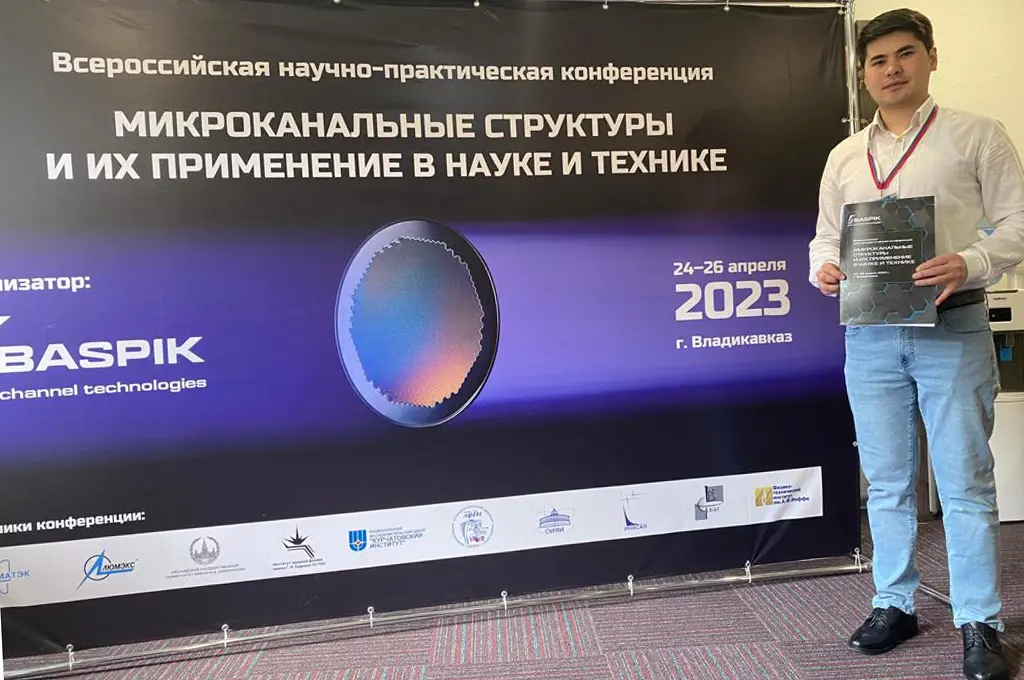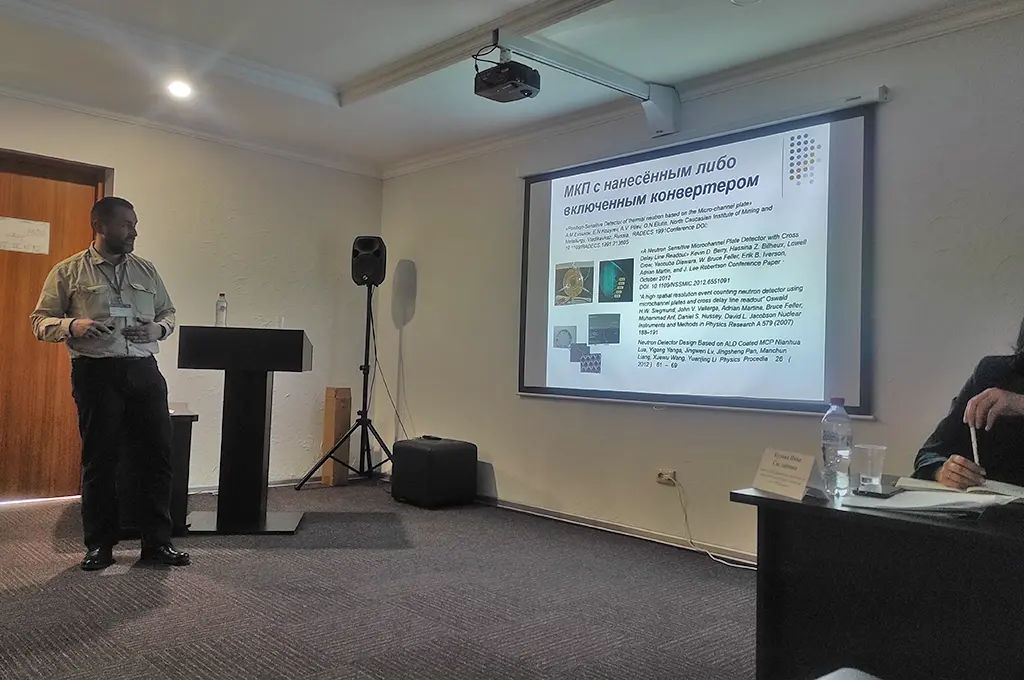On April 24-26, 2023, the Vladikavkaz Technology Centre “BASPIK” held the first all-Russian conference on the special applications of microchannel plates (MCPs) and MCP detectors.
Representatives of the country’s largest scientific organizations and universities took part in the event: MEPhI, A.F. Yoffe Institute of Nuclear Physics, Kurchatov Institute, Budker Institute of Nuclear Physics SB RAS, Institute of Astronomy RAS, A.V. Rzhanov Institute of Semiconductor Physics, Lebedev Physical Institute, P.N. Lebedev Physical Institute, RTU MIREA. Online and offline presentations were made by heads and representatives of the laboratories of the Joint Institute for Nuclear Research (JINR), INFN National Institute of Nuclear Physics (Italy). In terms of the importance of the topics discussed, as well as the level of scientific reports, the conference (according to the participants themselves) could well claim to be an international event in its area of expertise.
The participants gathered in the village of Verkhny Fiagdon (Roza Vetrov complex, RNO-Alania), where a busy scientific agenda of 23 papers was presented over the two days. Experts from the Laboratory of Detector Technology at VTC Baspik spoke about the company’s latest developments in the field of microchannel detection devices. Some of these have already been put into series production, while others have been presented to potential customers for the first time. The company’s latest developments include secondary electron multipliers with an extended dynamic range and fast response open-type MCP detectors. Both types of products are used in mass spectrometry equipment, which is being actively developed in our country.








VTC Baspik engineers also presented models of photomultiplier tubes for single photon counting as well as position-sensitive detectors, which are manufactured at the company on the basis of large-area microchannel plates.
The company’s main product lines are well known to the participants of the conference. The potential applications of MCP products in nuclear physics projects, space research missions, as well as for the development and production of industrial analytical equipment were revealed in detail in the reports of leading Russian and international experts in the field. For instance, A.A. Baldin, head of the JINR Laboratory of High Energy Physics, spoke about the use of large-area VTC Baspik MCPs as part of the detectors of circulating and ejected beams of the NICA accelerator complex. A representative of the same international organization, D.T. Aznabaev, presented the results of tests of the MCP-based time-of-flight system as part of the high-resolution magnetic analyzer MAVR, located at the heavy ion beams of the accelerator complex of the Nuclear Reaction Laboratory. For many years, JINR has been developing position-sensitive detectors (PSDs) based on highly sensitive MCPs as part of the diagnostic units of various nuclear physics experiments, where it is necessary to measure the rate and mass of the resulting products of nuclear reactions.
Another area of basic physical science is being developed at the Budker Institute of Nuclear Physics, Siberian Branch of the Russian Academy of Sciences. Here, a collaboration is being assembled with participation of VTC Baspik for the Super Charm Tau Factory – the projected electron-positron collider. The project is one of six megascience projects and is due to be completed by 2028 with a variety of detector units, including MCP-based scintillation PMTs.
The conference focused on the application of various types of secondary electron multipliers (SEMs) as part of mass spectrometers. The critical requirements for these components were explained in detail and the supply volumes of interest in the long term were outlined. In 2022, VTC Baspik participated in the implementation of the R&D of the NRNU MEPhI on the development of a triple quadrupole mass spectrometer specifically in terms of the development of a SEM with an extended dynamic range. This type of device provides new perspectives not only for scientific but also for high precision analytical work in the fields of food quality monitoring, pharmaceutical development, import phase-out of medical diagnostic equipment, drug and toxicology control, and forensic research based on the analysis of biological fluids. At the conference, this topic was also discussed with the participation of representatives of major industrial manufacturers of analytical equipment – Lumex Group and the Chromatec R&D centre. In the course of the discussion about the company’s capabilities, new product areas based on polycapillary optics were also identified which could be realized on the basis of the company. As a result, several new products for which a demand has been identified have already passed the prototyping stage at the company.
Representatives of the Kurchatov Centre (O.A. Raznitsyn, S.V. Stepanov) discussed opportunities for mastering equipment important for many industries – atomic probe tomographs. These devices also use MCPs with particularly large dimensions (100×100 mm). The application of MCP-based detectors for X-ray and neutron imaging was presented by the Physical Institute of the Academy of Sciences ( FIAN) (M.A. Karpov). There are good prospects here for the development of high-sensitivity radiological equipment based on large-area MCP detectors.












A particular section of the conference dealt with the medium- and long-term objectives of Russia’s major space projects. The representative of the Department of Experimental Astronomy of the Astronomical Institute of the Russian Academy of Sciences (A.S. Shugarov) spoke about the importance of the international project ‘Spectrum-UV’ involving Russia, Spain and Japan. With the launch of the spacecraft being developed under the project, Russian science will have monopoly access to observations of high spatial and spectral resolution in the UV range. There is every reason to believe that the Spectrum-UV will surpass the Hubble Telescope in many respects. The planned UV astronomy techniques will provide answers to such topical questions as the study of the evolution of the Universe, the physical and chemical composition of exoplanet atmospheres, the search for black holes, neutron stars, the study of the properties of interstellar matter and, most importantly, the search for free oxygen and ozone, which are reliable indicators of life on other planets. For the Spektr-UV project, VTC Baspik is developing an UV MCP detector that guarantees maximum sensitivity and stability in space.
The third day of the business agenda was dedicated to getting to know the company’s production and laboratory facilities, exchanging production experiences and formulating possible plans for joint training programs for young researchers. Of course, it was not without an extensive excursion program to the mountain gorges of the republic and an introduction to the peculiarities of national culture and history of North Ossetia.



At the end of the conference, participants recognized the obvious usefulness of such a format of discussions and agreed to hold them regularly in order to bring representatives of Russian science and knowledge-intensive industries closer together.